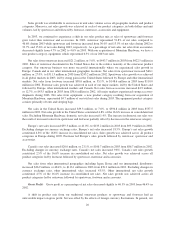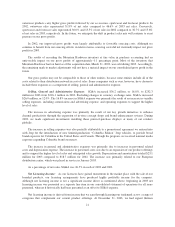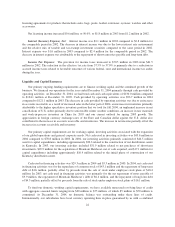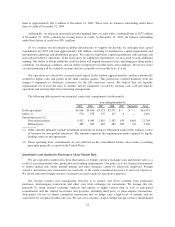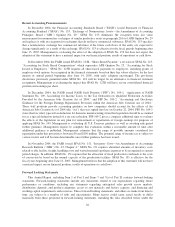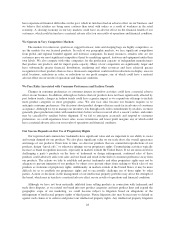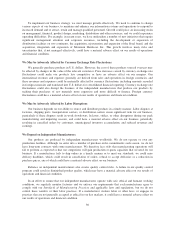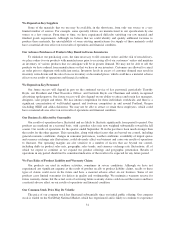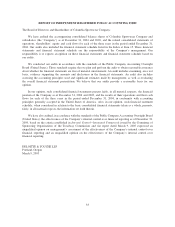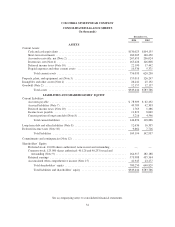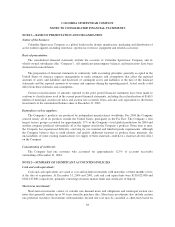Columbia Sportswear 2004 Annual Report Download - page 35
Download and view the complete annual report
Please find page 35 of the 2004 Columbia Sportswear annual report below. You can navigate through the pages in the report by either clicking on the pages listed below, or by using the keyword search tool below to find specific information within the annual report.To implement our business strategy, we must manage growth effectively. We need to continue to change
various aspects of our business, to maintain and enhance our information systems and operations to respond to
increased demand and to attract, retain and manage qualified personnel. Growth could place an increasing strain
on management, financial, product design, marketing, distribution and other resources, and we could experience
operating difficulties. For example, in recent years, we have undertaken a number of new initiatives that require
significant management attention and corporate resources, including the development or expansion of
distribution facilities on two continents, the acquisition, rejuvenation and expansion of the Sorel brand, and the
acquisition, integration and expansion of Mountain Hardwear, Inc. This growth involves many risks and
uncertainties that, if not managed effectively, could have a material adverse effect on our results of operations
and financial condition.
We May be Adversely Affected by Currency Exchange Rate Fluctuations
We generally purchase products in U.S. dollars. However, the cost of these products sourced overseas may
be affected by changes in the value of the relevant currencies. Price increases caused by currency exchange rate
fluctuations could make our products less competitive or have an adverse effect on our margins. Our
international revenues and expenses generally are derived from sales and operations in foreign currencies, and
these revenues and expenses could be materially affected by currency fluctuations, including amounts recorded
in foreign currencies and translated into U.S. dollars for consolidated financial reporting. Currency exchange rate
fluctuations could also disrupt the business of the independent manufacturers that produce our products by
making their purchases of raw materials more expensive and more difficult to finance. Foreign currency
fluctuations could have a material adverse effect on our results of operations and financial condition.
We May be Adversely Affected by Labor Disruptions
Our business depends on our ability to source and distribute products in a timely manner. Labor disputes at
factories, shipping ports, transportation carriers, or distribution centers create significant risks for our business,
particularly if these disputes result in work slowdowns, lockouts, strikes, or other disruptions during our peak
manufacturing and importing seasons, and could have a material adverse effect on our business, potentially
resulting in cancelled orders by customers, unanticipated inventory accumulation, and reduced revenues and
earnings.
We Depend on Independent Manufacturers
Our products are produced by independent manufacturers worldwide. We do not operate or own any
production facilities. Although we enter into a number of purchase order commitments each season, we do not
have long-term contracts with some manufacturers. We therefore face risks that manufacturing operations will
fail to perform as expected or that our competitors will gain production or quota capacities that we need for our
business. If a manufacturer fails to ship orders in a timely manner or to meet our standards, we could miss
delivery deadlines, which could result in cancellation of orders, refusal to accept deliveries or a reduction in
purchase prices, any of which could have a material adverse effect on our business.
Reliance on independent manufacturers also creates quality control risks. A failure in our quality control
program could result in diminished product quality, which may have a material adverse affect on our results of
operations and financial condition.
In an effort to ensure that our independent manufacturers operate with safe, ethical and humane working
conditions, we regularly monitor factories and we enforce our requirements that each manufacturer agree to
comply with our Standards of Manufacturing Practices and applicable laws and regulations, but we do not
control these vendors or their labor practices. If a manufacturer violates labor or other laws, or engages in
practices that are not generally accepted as ethical in our key markets, it could have a material adverse effect on
our results of operations and financial condition.
30


